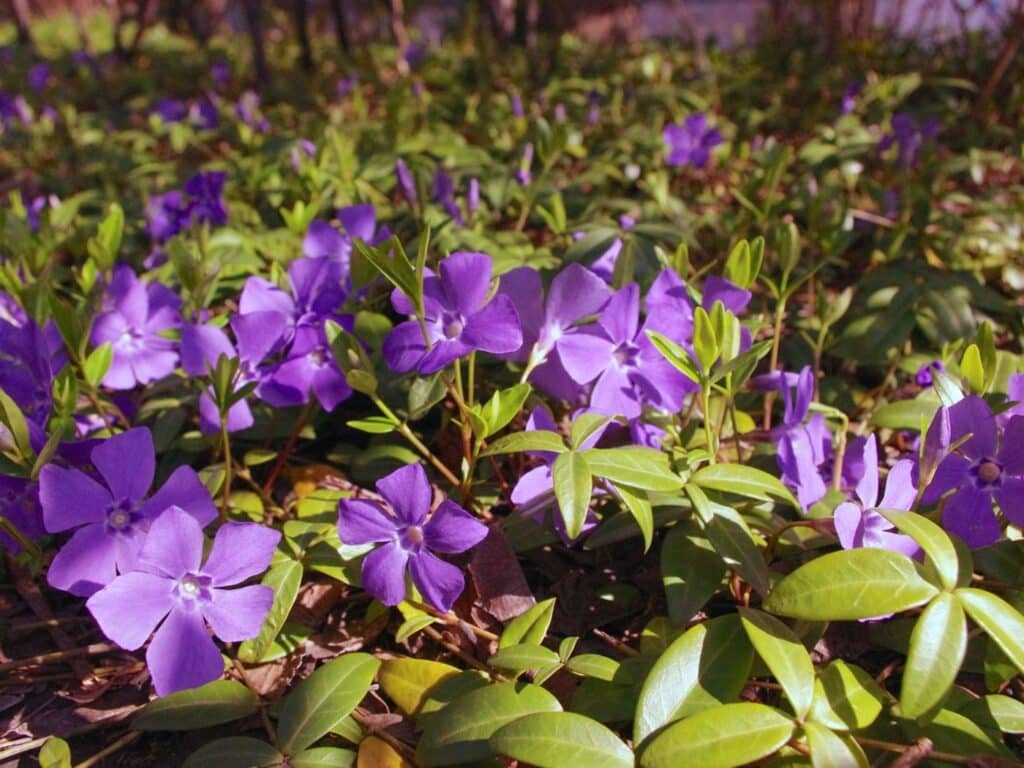Discovering your vinca leaves turning yellow can be disheartening, especially when you’ve put time and effort into nurturing your garden. This common issue, however, is not just a sign of despair but a call to action.
Yellowing leaves can indicate several underlying problems, from water stress to nutrient deficiencies, each requiring a unique approach to remedy.
Understanding why your vinca leaves are losing their vibrant green hue is the first step toward reviving your plants.
In this article, we’ll guide you through the potential causes and provide practical solutions to restore the health and beauty of your vincas. Get ready to roll up your sleeves and breathe new life into your garden.
Understanding Vinca Leaves and Yellowing
What Causes Leaves to Turn Yellow?
Leaf yellowing, often seen in vinca plants, is more than just a visual concern; it’s an alert. This issue typically stems from several factors. Over-watering or under-watering tops the list, leading to stressed plants that can’t function properly.
Nutrient deficiencies, especially a lack of essential elements such as nitrogen, potassium, or magnesium, play a significant role. Too much sun can also contribute, bleaching and weakening the leaves over time.
Finally, root rot or fungal diseases triggered by poor drainage or over-watering can attack the roots, impairing the plant’s ability to absorb water and nutrients, leading to yellowing leaves.
Signs of Unhealthy Vinca Plants
Identifying unhealthy vinca plants early can save you a world of trouble and your plants. Yellowing leaves are the most obvious sign, but watch for wilting or drooping, another clear indicator of distress.
Stunted growth or leaves that are smaller than usual suggest nutrient shortages or root problems. Also, look out for spots or blisters on leaves, symptoms of fungal infections or pests. Acknowledging these signals promptly can help in reversing the damage and ensuring your vincas thrive.
Common Reasons for Yellowing Vinca Leaves

Nutrient Deficiencies in Soil
Your vinca plants may well be throwing a yellow flag due to nutrient shortages. They crave a balanced meal, just like us. If the soil lacks vital nutrients, especially nitrogen, your vincas can’t synthesize enough chlorophyll.
This process is crucial for keeping their leaves green. Conducting a soil test can reveal what’s missing in their diet and guide you on how to amend the soil.
Overwatering and Poor Drainage
Too much water is just as problematic as too little. Vincas prefer their soil like a moist cake, not a soggy swamp. Overwatering, coupled with inadequate drainage, can drown the roots, leading to yellow leaves.
Ensure the planting site or pot has good drainage and adjust your watering schedule according to weather conditions. Vincas love a drink, but not a bath.
Pests and Diseases
Unwelcome guests, such as aphids and fungal diseases like root rot, can turn vinca leaves yellow. These pests and pathogens attack the plant, disrupting nutrient uptake and causing stress.
Regularly inspect your plants for signs of infestation and take prompt action. Often, a mild insecticidal soap or fungicide does the trick to send these invaders packing.
Environmental Stress Factors
Sometimes, yellowing leaves are vincas’ way of saying they’re not happy with their current location. Too much direct sunlight can scorch their leaves, while too little light can weaken them.
Check if your plants are getting the right amount of light and consider relocating them if necessary. Also, extreme temperatures or sudden changes in weather can stress your vincas out. Providing some shade during the hottest part of the day or sheltering them from cold drafts can make a world of difference.
Remember, yellow leaves are your vincas’ cry for help. By understanding these common causes, you can swiftly address the issue and get your garden thriving again.
Diagnosing the Problem
How to Assess Your Vinca’s Health
Observing your vinca plants closely is crucial to identifying the root cause of yellow leaves. Start by examining the soil moisture—vinca prefers well-drained soil, so either waterlogged or bone-dry conditions can stress the plant.
Next, check for signs of pests or disease by inspecting both the tops and undersides of the leaves. If you spot any unusual patterns or growths, jot them down.
Finally, assess the plant’s exposure to sunlight. Vincas thrive in full sun to partial shade, so if your plant’s getting too much sun or not enough, adjusting its location may well be necessary.
When to Consult a Professional
If after your initial assessment, the yellowing persists or worsens, bringing in a professional may well be wise. Specialists in plant healthcare can offer a precise diagnosis, especially if the problem stems from a complex disease or a pest infestation that’s hard to identify with an untrained eye.
Furthermore, if your soil test reveals severe nutrient imbalances, a professional can recommend the best course of action. Remember, there’s no harm in asking for help, especially if it saves your garden from further distress.
Care Tips for Healthy Vinca Plants
Vinca plants, with their beautiful blooms and glossy leaves, add charm to any garden. However, keeping them vibrant and avoiding issues like yellowing leaves demands attention to their specific needs. Let’s dive into some care tips that can help your vinca plants thrive.
Proper Watering Techniques
Overwatering or underwatering can lead your vinca plant into trouble. Aim for the Goldilocks zone — just right. Typically, vincas prefer their soil to be slightly moist. During dry spells, water your plants deeply but infrequently to encourage root growth.
A good rule of thumb is to allow the top inch of soil to dry out before watering again. Remember, these plants can handle a miss now and then, but consistency is key to avoiding stress.
Soil and Fertilization Recommendations
Vinca plants aren’t too picky, but they do appreciate well-draining soil rich in organic matter. Incorporating compost or a slow-release fertilizer at planting time can give them the boost they need.
Pacing the feedings according to the product’s instructions, usually every 6 to 8 weeks, supports their growth and flowering without overwhelming them. Listen to your plants; if they’re looking lackluster, a bit more nutrition may well be what they’re whispering for.
Adequate Sunlight and Placement
Sunlight is a love language for vinca plants, but too much of a good thing can lead to issues, including yellow leaves. They thrive in full to partial sun, so finding a spot that gets a mix of direct and filtered light throughout the day is ideal.
If your garden has spots that are sunny in the morning but shaded in the afternoon, that’s a prime location for vincas. Adjust their placement based on how they respond — if they start to look sunburned, a bit more shade may well be necessary.
By keeping an eye on watering, ensuring the right soil and nutrients, and choosing the perfect spot for sunlight, your vinca plants will have everything they need to keep their leaves green and their flowers blooming. Remember, gardening is a learning process—observe, adapt, and watch your garden flourish.
Treating Yellow Leaves on Vinca Plants
Facing yellow leaves on your vinca plants can feel like a puzzle. But, fear not! With the right steps, you can restore their lush, green vitality. Let’s dive into some effective treatments.
Adjustments in Watering Habits
Over-watering or under-watering your vinca plants is a common misstep. These plants like their soil to stay evenly moist, not drenched or bone dry. Check the soil moisture by sticking your finger an inch deep. If it feels dry, it’s time to water.
On the flip side, if the soil is constantly wet, you may well want to cut back on watering frequency. Also, ensure the plant pot has adequate drainage to prevent water from pooling at the bottom.
Treating Pests and Diseases
Pests and diseases can take a toll on your vinca’s health, leading to yellow leaves. Aphids and spider mites are the usual suspects. A gentle wash with soapy water can dislodge these tiny invaders.
For fungal issues, such as root rot, a fungicide may well be necessary. However, prevention is key. Avoid wetting the foliage when watering and ensure good air circulation around your plants.
When to Prune or Replace Your Plant
Sometimes, despite your best efforts, a few leaves may well remain yellow. Pruning these off can redirect energy to healthier parts of the plant. Use clean, sharp scissors and cut the yellow leaves at their base.
If the plant is severely affected and doesn’t improve, replacing it may well be your best bet. This gives you a fresh start and prevents the spread of any potential diseases to nearby plants.
Just remember, vinca plants are quite resilient. With a little care and watchfulness, you can overcome the challenge of yellow leaves.
Keep an eye on watering practices, be vigilant about pests and diseases, and don’t be afraid to prune when necessary. Your vinca plants will thank you with vibrant growth and colors.
Frequently Asked Questions
Why are my vinca leaves turning yellow?
Vinca leaves turning yellow can be caused by several factors including water stress, nutrient deficiencies, and pests. Identifying the specific cause is essential for proper treatment.
What are the signs of early detection for yellowing vinca leaves?
Early signs include wilting, stunted growth, and the yellowing of leaves. Catching these symptoms early can prevent further damage to the plants.
How can I ensure the health of my vinca plants?
Ensuring healthy vinca plants involves proper watering, using well-draining soil rich in organic matter, maintaining balanced sunlight exposure, and monitoring for pests and disease.
What soil is recommended for vinca plants?
Use well-draining soil that is rich in organic matter. This helps maintain the right moisture level and provides essential nutrients to the plants.
How much sunlight do vinca plants need?
Vinca plants require a balance of sunlight. They thrive in conditions that provide adequate but not excessive sunlight, depending on the specific variety.
What are the effective treatments for yellow leaves on vinca plants?
Effective treatments include adjusting watering habits, treating pests and diseases early, and pruning affected areas. Sometimes, replacing the plant might be necessary if it’s too damaged.
How can I adjust my watering habits to prevent yellow leaves?
To prevent yellow leaves, maintain soil moisture without overwatering. Ensure the soil drains well and adjust watering based on weather conditions, watering more in dry conditions and less in wet conditions.
Up next:







